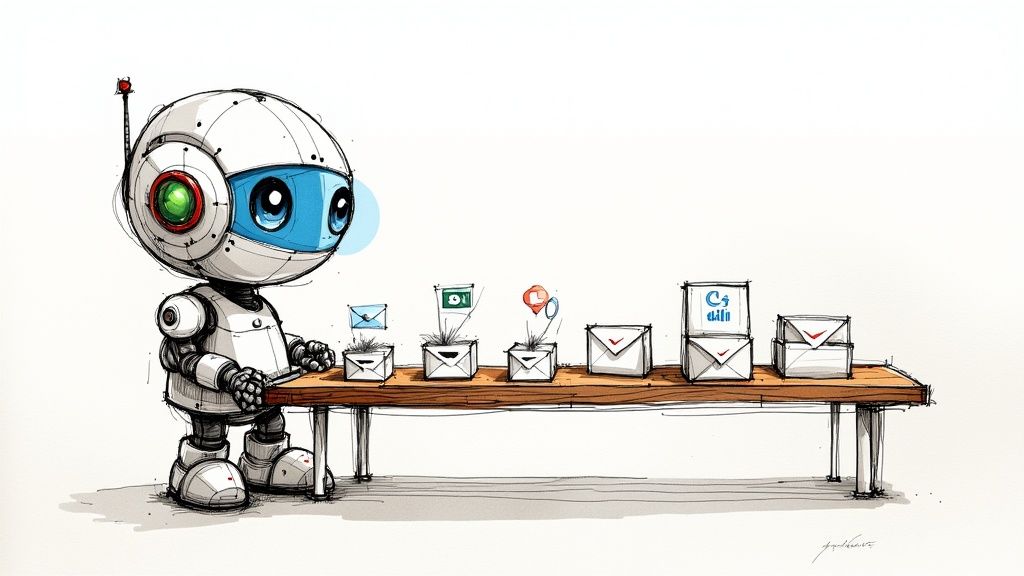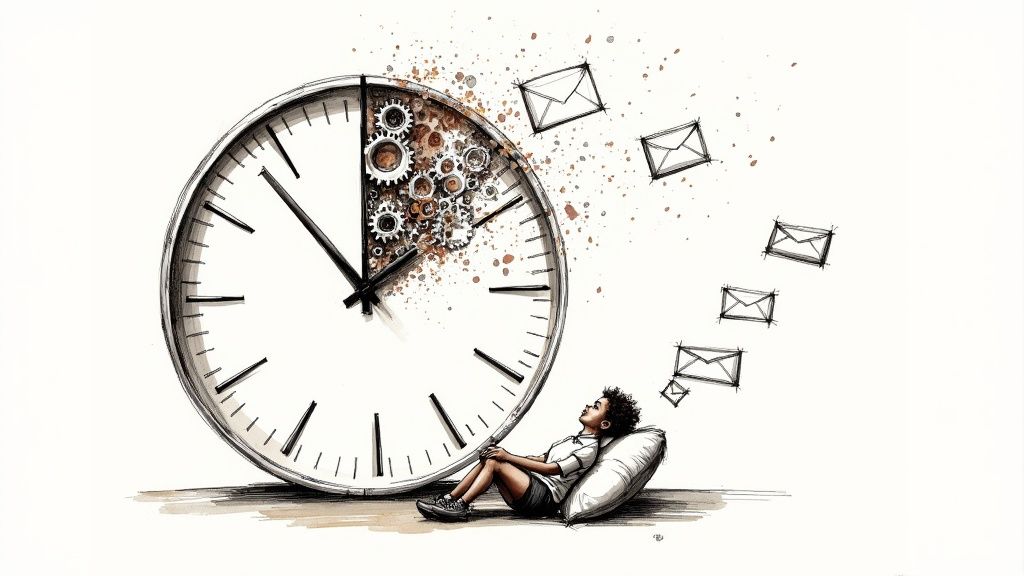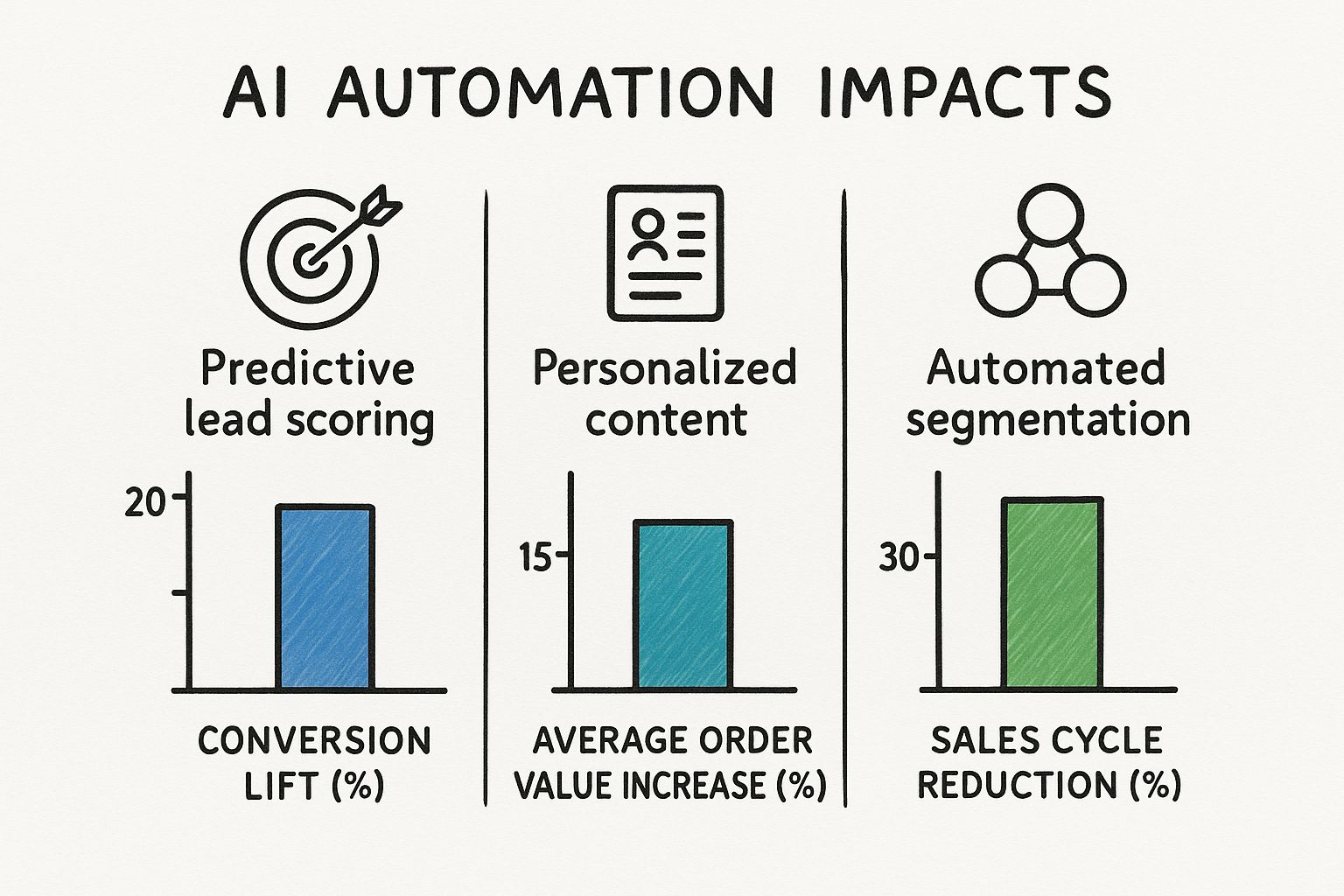Benefits Marketing Automation: How to Get More Done in Less Time
Marketing automation is your secret weapon. It saves time, delivers better leads, and keeps your customer experience locked in—even when you’re offline. For a lean startup, it's like cloning yourself. It’s a digital teammate handling the grunt work 24/7 so you can build your business.
Stop Manual Work. Start Automating Growth.

As a founder, you're wearing a dozen hats. Every minute spent on manual follow-ups or social media scheduling is a minute stolen from product, strategy, or customer calls.
This is where marketing automation flips the script. It’s not just a tool; it’s a new operating system for your business.
Think of it as setting up a series of dominos. Instead of pushing each one—sending every welcome email, tracking leads in a messy spreadsheet—you build automated "workflows" that fire off on their own. One action triggers the next, seamlessly.
The result? No lead ever falls through the cracks. Every new customer gets a warm, consistent welcome.
How Automation Gives Lean Teams Superpowers
For bootstrapped founders, this isn't a nice-to-have. It's a massive advantage. You can build sophisticated marketing funnels that rival bigger companies, all without the headcount.
Here’s what that looks like in action:
Lead Nurturing on Autopilot: Set up a drip campaign to automatically send helpful emails to new subscribers, guiding them from curious to convinced.
24/7 Customer Engagement: Deploy a simple chatbot to answer common questions or qualify leads while you’re offline. It's your round-the-clock front desk.
Hyper-Personalized Experiences: Automatically segment your audience based on clicks, views, or purchases. Then, send them content so relevant it feels like you're reading their minds.
Before we dive deeper, let's cut to the chase.
The Core Benefits of Marketing Automation: At a Glance
Benefit Area | Your Actionable Edge |
|---|---|
Time Savings | Ditch repetitive tasks. Reinvest your hours into strategy and product. |
Lead Quality | Automate lead nurturing and scoring. Focus your energy on prospects ready to buy. |
Consistency | Deliver a standardized, high-quality experience to every customer, every time. |
Scalability | Build a marketing engine that handles 100 or 100,000 customers without hiring an army. |
Data & Insights | Get hard data on what works. Make smart marketing decisions, not guesses. |
This table says it all: automation isn't just about efficiency. It's about building a smarter, more scalable business from day one.
The goal isn't to replace humans. It's to automate the predictable stuff so you have more time for meaningful conversations with your best prospects and customers.
If you're ready to swap manual grunt work for a system that drives growth, it's time to get started.
By setting up these systems early, you build a foundation that scales with you. Your marketing starts working for you, not the other way around.
The Unbeatable ROI of Smart Automation
For any founder, every dollar counts. This is where marketing automation shines, delivering its biggest benefit: a massive return on investment (ROI). It's not about saving a few hours; it's about turning your marketing budget into a lean, mean, revenue-generating machine.
Forget theory. Let's talk numbers. Smart automation connects every action to a financial outcome. You can literally watch a welcome email series turn a subscriber into a paying customer. You're not just sending emails; you're building a predictable engine for growth.
The Financial Power of Automated Email
Email marketing is the cornerstone of automation, and for good reason: it's a powerhouse. Done right, automated email campaigns deliver returns that make other marketing efforts look lazy.
The stats are mind-blowing. For every $1 you invest in email marketing, you can expect an average return of $36. That's a 3600% ROI. This makes automated email one of the most profitable channels available, often blowing paid ads out of the water. You can discover more insights about the profitability of marketing automation and see the proof.
This is exactly why building and automating your email list is one of the highest-impact moves a startup can make.
Refining Your Funnel for Maximum Revenue
But the real magic isn't just setting it up. It's in using automation to constantly improve your results. This isn't a "set it and forget it" tool; it's a dynamic system for optimization.
The goal isn't just to automate tasks. It's to automate growth. Test and refine every step of your customer journey to create a system that becomes more profitable over time.
Think of your automation setup as a built-in marketing lab. Run endless experiments to find what resonates. Here are two ways to do this right now:
A/B Test Everything: Stop guessing. Set up automated A/B tests in your email workflows. The system finds the winning headline, call-to-action, or send time and automatically uses it. Squeeze every drop of performance from your campaigns.
Use Dynamic Content: Ditch the one-size-fits-all message. Dynamic content blocks show different offers or images based on a subscriber's past behavior. An e-commerce store can show a deal on running shoes only to people who've browsed that category. Relevance skyrockets, and so do conversions.
When you bake these tactics into your automation flows, you stop "sending emails" and start building a self-improving sales funnel that fattens your bottom line.
Gain Back Your Most Valuable Asset: Time

As a founder, time is your most finite resource. Every hour sunk into repetitive tasks is an hour you can't spend talking to customers, refining your product, or thinking big picture.
Marketing automation delivers its most tangible win first: it claws back those hours.
It gets you out of the daily grind. Think about nurturing a new lead manually. You're stuck in a reactive loop of follow-ups and reminders. It's exhausting and inefficient.
The real power of automation lies in systematizing success. It takes best practices out of your head and turns them into a reliable, 24/7 process that works even when you don't.
Let's look at a quick "before and after."
The Manual Grind vs. The Automated Flow
Imagine someone signs up for your newsletter. Doing it by hand is a mess.
Day 1: You get a notification. You make a mental note to send a welcome email.
Day 2: You finally carve out 15 minutes to draft something.
Day 5: You remember to check if they opened it and decide to follow up.
Day 10: You add them to a spreadsheet, but then a server goes down and you forget.
This process is a time sink designed for human error. What happens when ten people sign up in one day? The system falls apart. Fast.
The Power of a "Set It and Forget It" System
Now, flip the script. You spend a few hours, one time, setting up an automated "welcome series." The system runs itself forever.
Instantly: The new subscriber gets a polished welcome email.
3 Days Later: The system automatically sends a follow-up with your best case study.
7 Days Later: A third email lands with a special offer.
This isn’t about saving a few minutes. It's about executing a flawless marketing campaign that's impossible for a lean team to manage manually.
Suddenly, you're operating like a much bigger company. Every lead gets a consistent, high-value experience, and you haven't lifted a finger. The efficiency boost is huge. One survey found that 22% of marketers saw efficiency gains of over 35%, while another 39% reported improvements between 15% and 35%.
Even better, this efficiency directly impacts well-being. Marketers consistently report less burnout after adopting automation. You can read more about how marketing automation improves efficiency and morale on Emailvendorselection.com.
This shift frees you to focus on the strategic work that actually moves the needle.
How AI and Automation Drive Real Revenue Growth
If standard automation is a tireless worker, adding Artificial Intelligence (AI) is like hiring a brilliant manager to run the whole operation. Your platform stops just doing things and starts thinking—making strategic decisions that grow your revenue.
This combo graduates you from simple "if-then" rules. Instead of reacting, your system predicts what customers will do next and gets ahead of them. Your marketing platform becomes a genuine growth partner.
Supercharge Your Strategy with AI
AI finds hidden patterns in your data that a human would almost certainly miss. This gives even the scrappiest teams the power to run sophisticated strategies once reserved for massive corporations.
Here’s how AI changes the game:
Predictive Lead Scoring: Stop treating every lead the same. AI analyzes behavior—every click, download, and page view—to identify who's ready to buy. It automatically surfaces the hottest leads, massively impacting conversion rates.
AI-Powered Personalization: Go beyond just using a first name. AI analyzes browsing history and past purchases to recommend the perfect product at the perfect moment, just like Amazon. This is true one-to-one marketing at scale.
Automated Customer Segmentation: Forget manual sorting. AI groups customers into hyper-specific segments in real-time based on their actions, letting you send incredibly relevant messages that drive action.
The financial payoff is real. Industry analysis shows AI-driven marketing solutions deliver an average ROI of 300%. Companies using AI see conversion rates jump by 40%, and their sales teams close deals 28% faster.
The chart below shows how these AI benefits translate into better business metrics.

As you can see, AI directly speeds up your sales cycle while boosting the value of every conversion. For bootstrapped founders, experimenting with the best free AI tools for marketing is a fantastic way to start without a big investment.
To truly unlock this growth, it pays to understand the tech behind it. Exploring the power of a Marketing Automation API shows you how to connect your tools and data into one intelligent system.
When you bring AI into the mix, you're no longer just reacting to what your customers did yesterday. You're anticipating what they'll need tomorrow.
High-Impact Automation Workflows for Lean Startups
Knowing automation helps is one thing. Putting it to work is another.
For bootstrapped founders, quick wins build momentum. This is your playbook—a short list of high-impact workflows you can set up today.
These aren't complex funnels that take weeks to build. They’re foundational blueprints designed to solve the most common startup headaches, from warming up leads to rescuing lost sales.
Nurture New Leads on Autopilot
The second someone subscribes, the clock starts ticking. A timely, relevant welcome is your best shot at making a great first impression. An automated lead nurturing sequence does this for you while you sleep.
This workflow kicks off the moment a user subscribes, dripping out a pre-written series of emails.
Email 1 (Immediate): Deliver what you promised (checklist, ebook) and give a warm welcome.
Email 2 (2 Days Later): Build credibility. Share something genuinely useful, like your best blog post or a case study.
Email 3 (5 Days Later): Introduce your product with a soft CTA, connecting it to a problem you know they have.
The goal: build trust and educate prospects before you ask for the sale. The metrics that matter are your email open rate and click-through rate.
Recover Abandoned Carts and Rescue Revenue
If you run an e-commerce store, abandoned carts are a fact of life. Studies show a staggering 69% of online carts are abandoned. That’s a massive pile of money left on the table. An automated recovery flow is your secret weapon to bring them back.
This single workflow is one of the most profitable automations you can build. It targets users who showed clear intent to buy but got distracted.
The sequence triggers the instant a user adds an item to their cart but leaves without checking out.
Email 1 (1 Hour Later): A gentle nudge. "Did you forget something?" Include a picture of the item and a direct link back to their cart.
Email 2 (24 Hours Later): Create urgency. "Your items are selling fast!" This is also a great place to handle common objections like shipping costs.
Email 3 (48 Hours Later): The final offer. A small discount or free shipping code can be the push they need. "Here's 10% off to complete your order."
Success is simple to measure: your cart recovery rate. For more ideas, explore other powerful marketing automation workflows that drive similar results.
Your First Three Automation Workflows
Don't try to build everything at once. Focus on these three foundational workflows for quick wins.
Workflow | Primary Goal | Key Metric to Track |
|---|---|---|
Welcome & Nurture Sequence | Build trust and educate new leads. | Email Open & Click-Through Rate |
Abandoned Cart Recovery | Rescue lost sales and boost revenue. | Cart Recovery Rate |
New Customer Onboarding | Reduce churn and turn buyers into fans. | Product Activation & Engagement Rate |
Each one tackles a different stage of the customer journey. Master these, and you'll have a solid foundation to build on.
Choosing Your First Marketing Automation Tool

Stepping into marketing automation feels like walking into a massive store with endless aisles. Every platform promises the world, making it easy to get overwhelmed and overspend on features you'll never touch.
For a bootstrapped founder, the goal isn't to buy the most powerful tool. It's to find the right tool that solves your immediate problems without torching your bank account. Ignore the shiny objects. Focus on what works.
The best marketing automation tool for a startup is the one you'll actually use. Prioritize simplicity and core functionality over a complex suite that creates more work than it saves.
Don't get sucked in by "enterprise-grade" promises. Right now, you just need a solid foundation that handles the basics flawlessly.
Focus on the Must-Have Features
Before you look at a pricing page, get crystal clear on what you need right now. For most startups, that list is surprisingly short.
Your checklist should boil down to these core functions:
Email Workflow Builder: Is it intuitive? A visual, drag-and-drop editor is non-negotiable.
Simple Segmentation: Can you easily tag and group contacts based on their actions, like clicking a link?
Basic Reporting: Does it give you the essentials—open rates, click-through rates, unsubscribes—without burying you in useless data?
Key Integrations: Does it play nice with your website builder or e-commerce platform?
Anything else is a "nice-to-have" for later. Fancy features like predictive lead scoring can wait until you've nailed the fundamentals.
Understand the Pricing Models
Finally, pay close attention to how platforms charge. The two most common models are per-contact (based on list size) and per-send (based on email volume).
For most startups, a per-contact model is more predictable and scales better. To find a platform that fits your budget without compromising, check out our deep-dive guide on marketing tools for startups.
Choosing wisely now sets you up for profitable growth, not financial headaches.
Still Have Questions About Marketing Automation?
Jumping into a new system brings questions. It's easy to get excited about the possibilities but smart to tackle the practical stuff first. This FAQ cuts through the noise with straight answers to the questions I hear most from founders.
This is your final gut check. We'll clear up common worries about cost, complexity, and whether your customers will think a robot replaced you.
Is Marketing Automation Too Expensive for a Bootstrapped Startup?
Not anymore. Modern platforms are built for startups, with affordable plans that scale with you. Look for tools with a freemium option or a low-cost plan based on your contact list size, not a bloated feature set.
Start small. Don't get suckered into paying for an enterprise suite when you just need a solid email workflow. The ROI from a single sequence—like an abandoned cart reminder—can often pay for the tool itself in months.
Do I Need to Be a Coder to Get Started?
Absolutely not. The best platforms today are built for marketers, not developers. They use intuitive drag-and-drop builders, visual editors, and pre-built templates.
The whole point of today's automation tools is to make sophisticated marketing accessible. If a platform feels like you need a computer science degree during the free trial, it's the wrong tool. Ditch it.
Focus on user-friendly platforms. Your first goal is to build a simple, three-email welcome series. This will build your confidence and teach you the ropes. You'll be shocked how fast you can create killer campaigns without writing a single line of code.
Will This Make My Communication Feel Robotic?
This is the number one fear, but it only comes true if you let it. Bad automation is robotic. Good automation delivers personalization at scale. It ensures every customer gets a consistent, relevant experience that's impossible to manage manually.
Here’s how to keep the human touch:
Use merge tags: Always use the customer's first name. It's basic, but it works.
Segment your audience: Group people based on what they do—like pages visited or products bought.
Use dynamic content: Show different offers or messages to different segments within the same email.
Done right, automation doesn't feel like a machine. It feels helpful. It feels like you're delivering the right message to the right person at the right moment.
At Viral Marketing Lab, we give bootstrapped founders the blueprints to execute powerful marketing strategies without the big-budget headaches. Explore our curated resources and find the playbooks that will accelerate your growth today.










